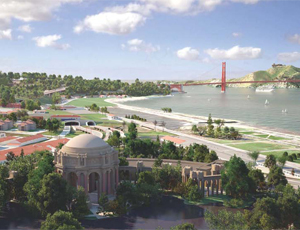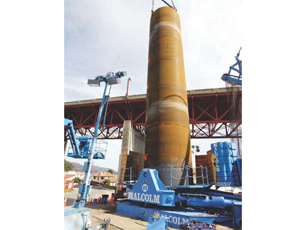... once in the ground. The pieces are then lifted by a 300-ton crane and set on the oscillator where they are cork screwed into the ground by two arms with hydraulic jacks. While the machine pushes the piles into the ground, it also grabs and excavates soil from the middle.


“Getting these cages up in the air without bending or destroying them was a challenge because we had to develop new lifting gear and procedures to align the cages properly and pour them,” says Faust, adding that the rebar cages weighed up 150-tons. “And we spent quite a bit of money doing this.”
Funded in part by $168 million from the American Recovery and Reinvestment Act, the Presidio Parkway is being constructed using eight separate and phased contracts.
To minimize traffic disruption, the first phase involves construction of new structures adjacent to the existing Doyle Drive so that the roadway can remain open.
“We’ve planned the construction phase to minimize disruptions to traffic,” says José Luis Moscovich, executive director of the San Francisco County Transportation Authority. “We will first build the southbound structures, then, in 2011, transfer traffic onto these completed structures and a temporary bypass while we demolish the old road and build the new northbound portions.”
The first major construction contract of $48.4 million was awarded to C.C. Myers in November 2009 to construct the new southbound viaduct bridge. In March, Walnut Creek-based R&L Brosamer Inc. was awarded a $57.7 million contract to construct a temporary bypass, a southbound tunnel and a section of permanent roadway. The first two contracts cover environmental mitigations and utility relocation, with contract two won by Ghilotti Bros. of San Rafael.


Post a comment to this article
Report Abusive Comment